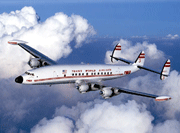E-Archive
Off the Beaten Track
in Vol. 12 - May Issue - Year 2011
Super Connie

TWA Super Connie
The voice coming from the speakers droned monotonously as the small boy pulled himself up on his knees at one of the window seats. He didn’t bother to listen to the description of the itinerary, how many stopovers and all that other information which his parents and the other adults on the aircraft appeared to find so interesting. The idea that in a few minutes he would be flying high in the sky was exciting enough, and he stared intently out the small, round window as the ground crew prepared the airplane for takeoff.
*****
Air travel in the United States developed in leaps and bounds in the early 1930’s, with several airlines being started up over a period of a few years. Competition among these companies soon became fierce, as each one vied to offer faster and more frequent service.
To meet this demand, aircraft manufacturers were under continuous pressure to develop bigger, faster and longer-flying aircraft which would allow airlines to gain a competitive edge over their rivals. Companies which had been started up as small, individual firms by engineers and entrepreneurs such as Bill Boeing, James McDonnell, Donald Douglas and the Loughead brothers (who later changed the name of their company to Lockheed for phonetic reasons) grew rapidly and were coming out with improved versions of their aircraft every few months.
Even before getting involved in the Spruce Goose project in the early 1940’s, American multimillionaire and aviation enthusiast Howard Hughes had set up his own aircraft company in order to pursue his keen interest in flight and in aircraft design. In 1939 he was persuaded to buy 25% of shares in an expanding airline called TWA, which had been the result of a merger in 1930 between two pre-existing airlines, Transcontinental Air Transport and Western Air. This airline had already started building a good reputation as a reliable and pioneering carrier, with some high-profile names such as Charles Lindbergh, Jack Frye and Eddie Rickenbacker among its shareholders and collaborators. That same year, at the insistence of Hughes, TWA asked Lockheed to develop a new aircraft capable of carrying forty passengers from coast to coast, with a range of at least 3,500 miles.
The result was an aircraft called the L-049 Constellation, revolutionary in design and performance. It was a pressurized four-engine propeller aircraft with a triple tail, in order to keep the overall height of the plane low enough to fit in hangars, and a distinctive dolphin-shaped fuselage. It featured new technologies such as hydraulically-assisted controls and a de-icing system on wing and tail leading edges. It had a cruising speed of 300 mph and a service ceiling of 24,000 feet. It is said that Howard Hughes intervened with Lockheed and heavily influenced the design, capabilities and appearance of the new aircraft.
For testing purposes, in April 1944, Howard Hughes and Jack Frye personally flew the second production model on a non-stop flight from Burbank, California to Washington, D.C, in just under seven hours. On their return flight to California, they stopped over in Ohio to pick up Orville Wright, the surviving member of the two-brother team credited with having made the world’s first powered and manned flight in 1903, and gave Orville his last airplane flight. The start of World War II diverted the L-049 to military use as a transport plane, when it was renamed the C-69 Constellation, and TWA had to wait until October 1945 before receiving its first aircraft. The airline inaugurated its first intercontinental flight, from New York to Paris, in February 1946. The aircraft quickly became very popular with passengers and pilots and was affectionately nicknamed “Connie”.
Quite predictably, Lockheed’s competitors were not standing still and the race to improve performance saw a series of better and better versions of the Constellation, eventually leading to the development of the L-1049G Super Constellation, nicknamed “Super Connie”. It was about 116 feet long, with a wingspan of 126 feet and, depending on the configuration, could seat from 62 to 109 passengers. Its four Wright R-3350 Turbo Compound engines could ensure a range of 5,400 miles. The Super Connie was soon providing regular service to destinations as far away as Cairo, Bombay, Bangkok, Hong Kong and Manila.
*****
And what about the small boy’s first flight? In 1957 he boarded a TWA Super Constellation with his parents and flew from Chicago to Milan in over twenty hours, stopping over in Montreal, Gander, Shannon and Paris before the family reached its final destination. For those years, truly a record-breaking flight!
By Giovanni Gregorat, Contributing Editor MFN & Sales Manager, Pometon Abrasives
Author: Giovanni Gregorat



























